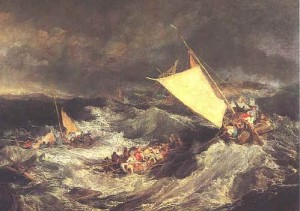I’ve been thinking about shipwreck and other oceanic matters while reading the papers and responses for what looks like a great SAA seminar coming up in Boston in two weeks.
Since I have just a few free hours this week, I thought I might return to an article that’s not due until late April, but which sings the same salty chorus. This chapter will eventually be part of the intro to the shipwreck book, though I first wrote this material for a great conference at the National Maritime Museum in Greenwich in fall 2010.
Here’s a little bit out of the beginning, which starts with this wonderful broadside, Richard Younge, The State of a Christian (1636) —
My Body is the Hull; the Keele my Back; my Neck the Stem; the Sides are my Ribbes; the Beames my Bones; my flesh the plankes; Gristles and ligaments are the Pintells and knee-timbers; Arteries, veines and sinews the serverall seames of the Ship; my blood is the ballast; my heart the principall hold; my stomack the Cooke-roome; my Liver the Cesterne; my Bowels the sinke; my Lungs the Bellows; my teeth the Chopping-knives; except you divide them, and then they are the 32 points of the Sea-card both agreeing in number…[i]
That manic voice insisting that human bodies and wooden ships occupy the same space is Richard Younge, from his broadsheet The State of a Christian (1636), a single-page work that also appears as a preface to Henry Mainwaring’s Sea-man’s Dictionary (1644). Its mania suggests how intensely and how physically oceanic experience stimulated the early modern imagination. Younge hurls human body parts, Christian souls, and nautical terms together. The resulting conceptual soup provides a frame through which to consider how shipwreck narratives reveal the dynamic meanings of the ocean in early modern English culture. Early modern shipwreck narratives were symbolic performances through which writers tested their own, and their culture’s, experiential knowledge of the ocean. Narratives of maritime disaster lay bare the tremendous practical and symbolic stress that the transoceanic turn created in English habits of orientation. Representations of shipwreck provide a resonant but unfamiliar model of cultural change in early modern English culture. To recast a celebrated modern poetic phrase about the sea, shipwreck is history.[ii]
[i] Richard Younge, “The State of a Christian, lively set forth by an Allegorie of a Shippe under Sayle,” appears as an introduction to Henry Mainwaring, The Sea-Man’s Dictionary, (London: John Bellamy, 1644), sigs. A3 – A3v. The passage is included in some copies of Younge’s The Victory of Patience (London: M. Allot, 1636). It was also published in a single sheet broadside as The State of a Christian (London, 1636).
[ii] I adapt Derek Walcott’s “Sea is History,” Selected Poems, Edward Baugh, ed., (New York: Farrar, Straus, and Giroux, 2007) 137.

Leave a Reply